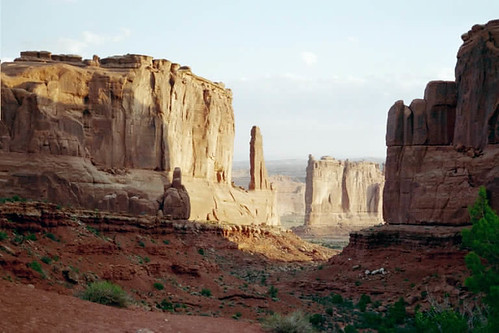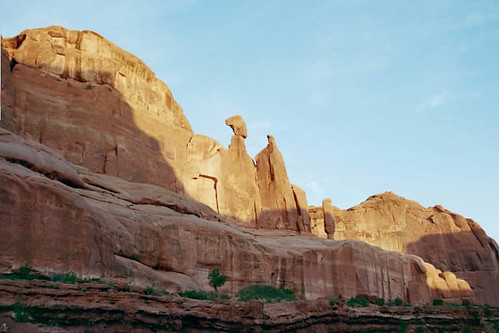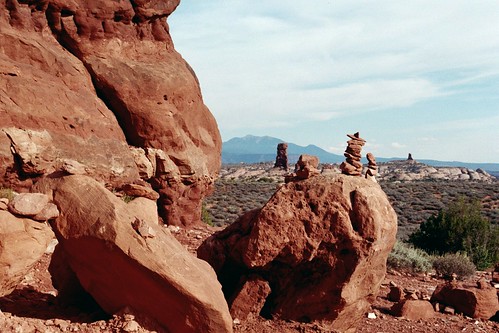
Arches National Park, Utah, USA is at the northern edge of the Colorado Plateau and may be one of the best known features of this huge sandstone tableland. Arches National Park contains the world's largest concentration of natural stone arches.
This park is a red desert, punctuated with eroded sandstone forms such as fins, pinnacles, spires, balanced rocks, and arches. The 73,000-acre region has over 2,000 of these "miracles of nature."
And the park brochure my sister and I picked up the first evening we entered the park said it could be seen in 2 to 2 1/2 hours. Five days later we were still making twice daily trips to photograph this arch or that arch or that pinnacle per a guide we found on line detailing whether morning or evening light was best. One of the most known arches is Delicate Arch shown above (photograph by the Utah Visitor's Center). But one of the most stunning views is Park Avenue, the first Kodak photo opportunity upon cresting the top of the mesa on a road that takes your breath away.

There is a 2 1/2 mile trail that passes through these fins and pinnacles. We didn't take it because it was 2 1/2 miles back and we were aware the morning that we photographed this wonderful view that we were not going to have enough time to photograph everything of beauty. We did go part of the way down the trail which gave us this view. I think it looks like a Pharaoh and his Visor parading toward the rising sun.

Trails are on sandstone or slick rock and so paths are difficult to see unless they are marked by stones something the National Park Service does very well. You very quickly learn to follow the carrions or stone stacks and to set them up yourself when crossing open territory. And it rapidly becomes a good luck action to add another stone on top. Being very careful, of course to not knock it over.

Below is a massive stone fin which can be seen for miles in all directions. Mother Nature is the mistress of stone piling though this is mostly one rock, one huge rock.

Fins (stone formations longer than they are wide) often erode into arches like the one below. I was trying to wait for everyone to move out of the picture when it dawned on me that this grouping within the window of the arch give the viewer a fell of the size of these formations.

The lines along its base indicate that the pushing up of this once sedimentary sea floor was not universally even. The vegetation is typical of high mesa land in the southwest.
For more information on Arches National Park I refer you to the Utah website and for a Map of the area.
Next Colorado Plateau post will have more photos of Arches and continue into nearby Canyonlands.
Charley
ReplyDeleteWhat wonderful pictures :) I have only driven through and not had time to really see this park...... maybe someday I can take the kids :)
Take care and thanks for the wonderful pics and inforamtion on this.
Thank you for your comments and your visit. I want to go back again even after all the time I did spend there I feel as if I have not really seen it totally.
ReplyDeleteI enjoyed reading this entry on Y360. I do like the layout here on Blogger.
ReplyDeleteThis really is extraordinary landscape. What did the Indians think of it?
ReplyDeleteThe Indians of the area think of it as very spiritual land. Like with the Navajo creation story of Coyote bringing the people up from the center of the earth that I related with my painting Coyote's Portal. They learned to honor the land and live off its sparse flora and fauna. Believe it or not there are deer, as well as various rodents, that live here.
ReplyDeleteThe white man called it the Bad Lands but for the likes of Butch Cassidy and the Sundance Kid this land was where you hid from the Texas Lone Rangers that tried to take the states of Utah, Wyoming, Colorado and New Mexico as part of their own cattle spread.
Lots of history here. See my post on Y!360 about the book Haunted Highways; Ghost Towns of New Mexico.